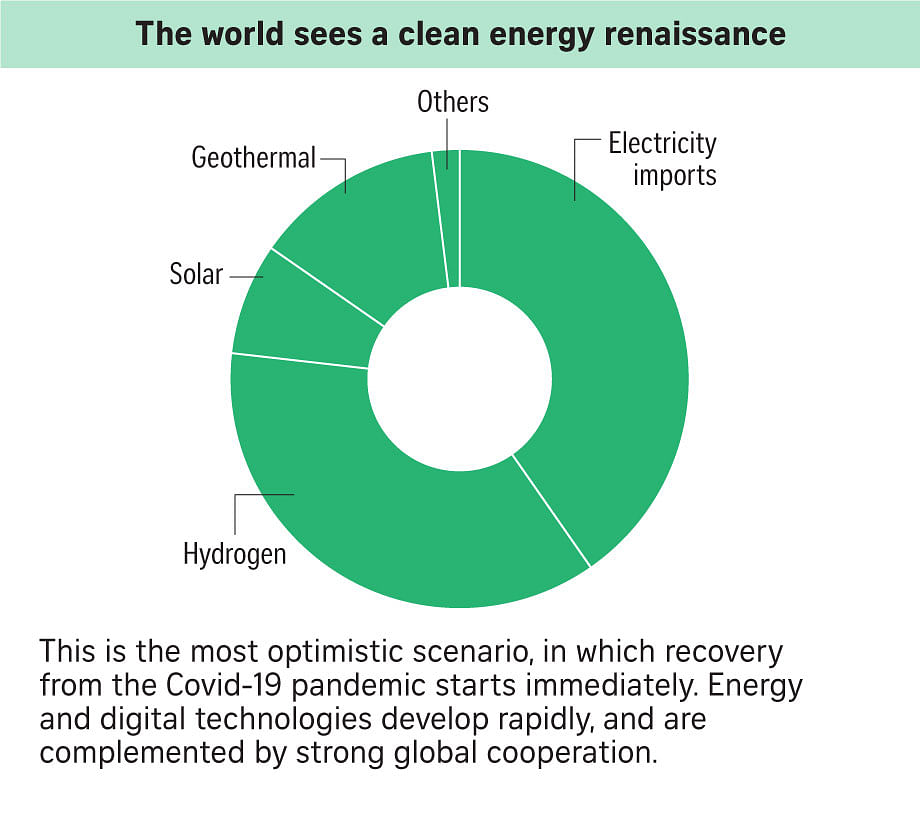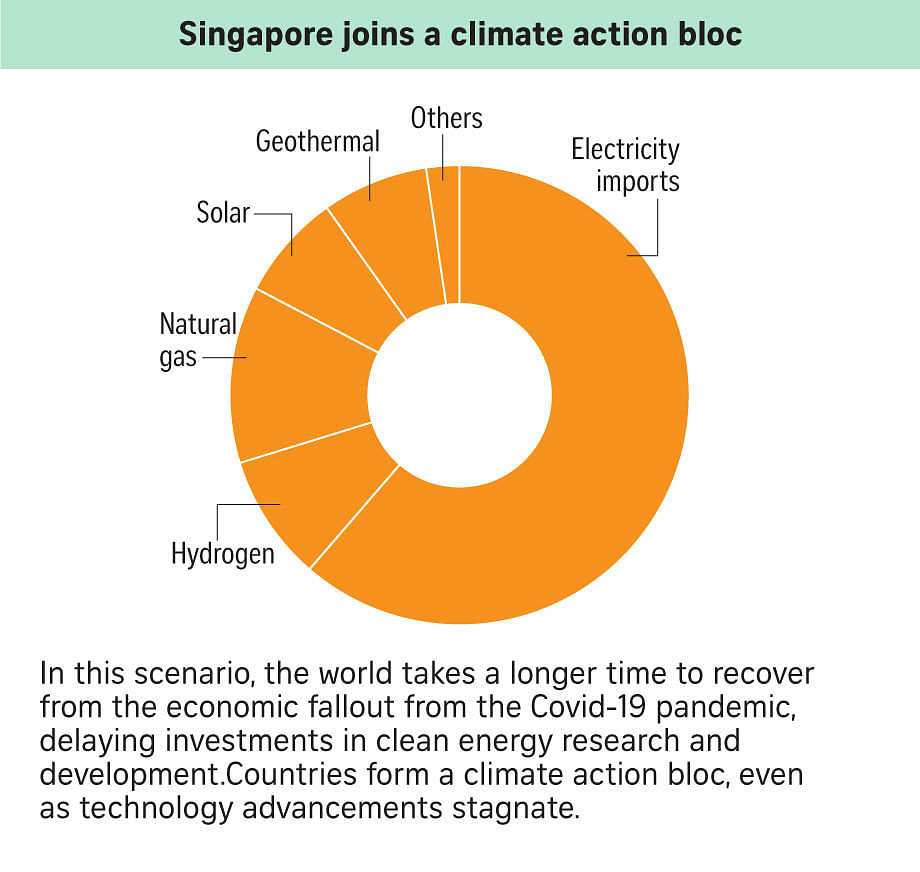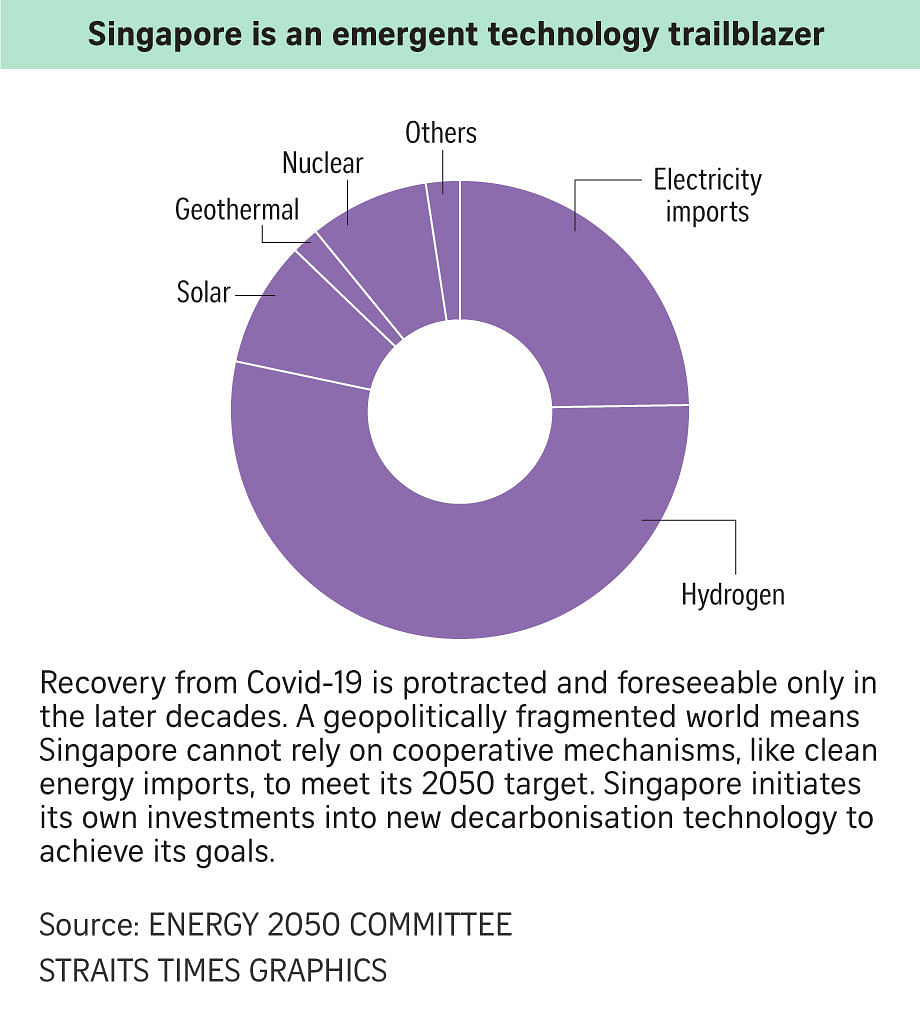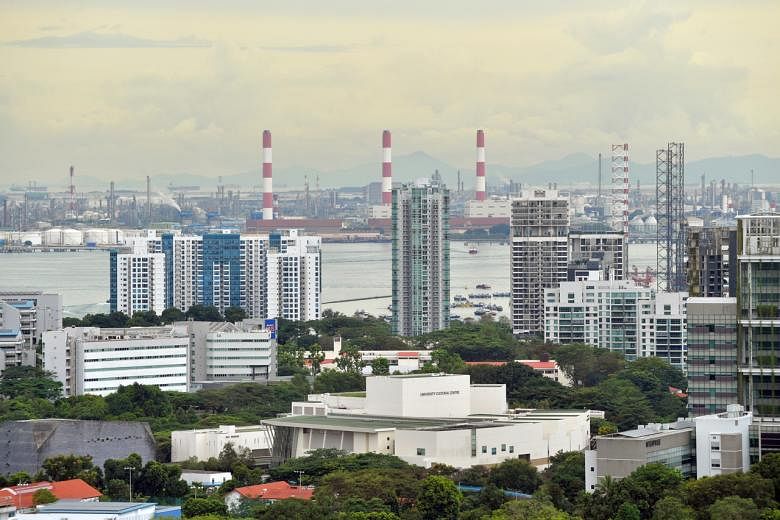SINGAPORE - Singapore's power sector now produces about 40 per cent of the country's emissions, but the sector could realistically bring this down to net zero by 2050, said a new report published on Tuesday (March 22).
The Energy 2050 Committee report, commissioned by industry regulator Energy Market Authority (EMA), said achieving this target can be done in ways that will neither compromise Singapore's energy security nor affordability.
Importing more clean energy into Singapore through regional power grids, developing infrastructure suitable for clean-burning hydrogen to be used as a fuel and maximising solar panel deployment are some of the strategies the report recommended, with inputs from energy experts.
The report comes after Singapore announced last month that it will aim for national emissions to reach net zero "by or around" that same mid-century timeline.
Most of Singapore's energy is generated by natural gas, a fossil fuel, which means burning it produces planet-warming emissions into the atmosphere.
The power sector accounts for about 40 per cent of the country's total emissions currently. About 45 per cent of national emissions comes from the industrial sector, while land transport here makes up about 14 per cent of the total emissions inventory.
But the power sector is likely to contribute a larger percentage to Singapore's emissions in the years ahead, especially with the move towards digitalisation and the electrification of vehicles here.
So if the emissions from the power sector can be tapered down to net zero, it would put the Republic in a better position to achieve its climate targets.

In the foreword of the 55-page report, EMA chairman Richard Lim said: "The world is now at an inflection point, with the global imperative of addressing climate change driving a shift towards a low-carbon future."
Singapore is committed towards this global endeavour, he said, adding that the energy sector will have to play a significant part in the nation's decarbonisation efforts.
Mr Lim, highlighting how Singapore lacks natural resources and the ability to access other forms of renewable energy other than solar, said the energy transition will require a clear-minded weighing of the trade-offs across energy security, energy affordability, and environmental sustainability.
The report by the committee - which comprises nine representatives from academia, policy and industry, who also consulted other energy experts on their views - sets out nine strategies in total for Singapore's power sector to achieve its net-zero target. The strategies include keeping abreast of research into emerging low-carbon technologies, such as nuclear or carbon capture; buying international carbon credits to offset emissions from any fossil fuels that have to be burned locally; managing energy demand; and leveraging digital technologies.
Development of multi-layered grids; and shaping end user consumption through demand-side technologies, such as smart energy management systems, are also recommended.
Singapore's current electricity grid is largely a single-layered one, where electricity produced by generation companies flow into the national grid that households and businesses draw on.
But there could be other sources of energy in a multi-layered grid, such as solar panels atop a building, for example.
In such a situation, there is a two-way flow of electricity, from the national grid to the users who may need energy during periods where the sun does not shine, for instance. Users can also sell electricity back to a multi-layered grid, during periods when their solar panels generate more than enough electricity to meet their needs.
Developing such a multi-layered grid, however, will require new systems and protocols to ensure electricity reliability and to more accurately match customer needs, the report noted. For example, this could include solid-state transformers and energy routers which will enable the control of bi-directional electricity flow.
Overall, pursuing the nine different strategies set out in the report will enable Singapore's power sector to stay nimble and in a good position to achieve its target despite the uncertainty in geopolitics and technological developments.
Chairman of the Energy 2050 Committee Choi Shing Kwok, who is also director and chief executive officer of research centre ISEAS - Yusof Ishak Institute, said the report found that Singapore's effort to reduce its reliance on fossil fuels over the next 30 years will be complex, with uncertainties around the options that will be available to Singapore.
Mr Choi, a former permanent secretary for the environment and water resources, added: "Given this, it is not possible to craft a single definitive long-term strategy today. Instead, Singapore will have to stay nimble... to constantly identify forks in the road and make investments at appropriate junctures to be well-positioned for new pathways as they open up."
The report charted out three potential scenarios on the power sector's path to net-zero emissions by 2050.
In the most optimistic scenario, energy and digital technologies develop rapidly and are complemented by strong global cooperation. This enables Singapore to achieve a diverse energy supply mix in 2050, with the ability to import energy from multiple countries and use low-carbon hydrogen as a key energy source.

Hydrogen is considered a clean fuel as it does not produce carbon dioxide when burnt. Technologies to store and generate hydrogen from renewable energy sources are still nascent, but this scenario assumes that research into this will provide answers.
A second scenario assumes a longer path to Covid-19 recovery, delaying investments into clean energy technologies that lead to a stagnation in new developments. However, countries band together, allowing Singapore to import clean energy generated elsewhere to meet its needs.
In this scenario, natural gas still features in Singapore's energy mix, although emissions are offset through the purchase of carbon credits from elsewhere.

Lastly, a third scenario assumes that the world is fragmented, and technology advancement is delayed but eventually pays off. Electricity imports contribute to the mix but their share of Singapore's energy mix is limited due to the slow development of the regional grid, the report said.
But Singapore, building on its earlier investments, can start deploying other low-carbon alternatives, such as nuclear energy, to diversify its supply mix and is well-positioned to scale them up further when they become more commercially competitive.

The report by the Energy 2050 Committee was commissioned by EMA in end-2020 to plan for the long-term future of Singapore's energy sector.
The committee is made up of members from three areas of expertise - technology and technology management, business and sustainable economy as well as policymaking.
It is chaired by Mr Choi and comprises nine members, including Mr Frank Phuan, co-founder of renewable energy firm Sunseap Group; Professor Chua Kee Chaing, president of the Singapore Institute of Technology; and Mr Hugh Lim, executive director at the Ministry of National Development's Centre for Liveable Cities.
A spokesman for EMA said it will further study the recommendations in the committee's report and announce new developments when ready.
Asked what Singapore's efforts to decarbonise the power sector would mean for electricity prices, the spokesman added that EMA will study the different options outlined in the report to ensure this is done in the most cost-efficient manner while ensuring reliability.
But she added that trade-offs are inevitable.
"We will need to invest in infrastructure and technology, which may be costly and likely to lead to higher electricity costs," said the spokesman.
"We will pace and manage the transition to ensure that electricity remains affordable and provide targeted assistance to vulnerable groups."

